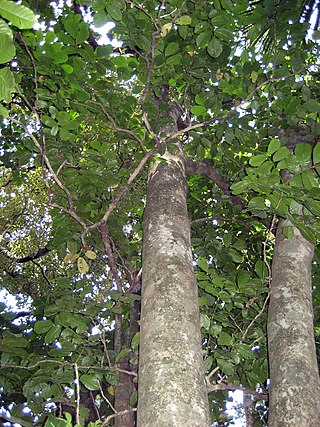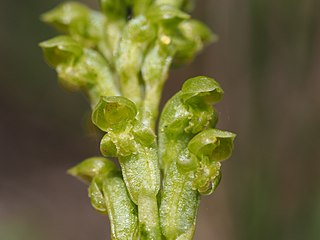
Myoporum laetum, commonly known as ngaio or mousehole tree is a species of flowering plant in the family Scrophulariaceae and is endemic to New Zealand. It is a fast growing shrub or small tree with lance-shaped leaves, the edges with small serrations, and white flowers with small purple spots and 4 stamens.

Myoporum is a genus of flowering plants in the figwort family, Scrophulariaceae. There are 30 species in the genus, eighteen of which are endemic to Australia although others are endemic to Pacific Islands, including New Zealand, and one is endemic to two Indian Ocean islands. They are shrubs or small trees with leaves that are arranged alternately and have white, occasionally pink flowers and a fruit that is a drupe.

Baloghia is a genus of plants under the family Euphorbiaceae first described as a genus in 1833. It is native to Australia, New Caledonia, and Vanuatu. Cocconerion is a close relative.

Arthropodium cirratum is a species of herbaceous perennial plant, endemic to New Zealand, where it may once have been farmed. It is used for medicine as well as food, and has symbolic importance in traditional Māori culture.

Kohekohe is a medium-sized tree in the Meliaceae family, native to New Zealand. It is found in lowland and coastal forests throughout most of the North Island and also occurs in the Marlborough Sounds in the north of the South Island. Mature trees grow up to 15 metres (49 ft) in height, with a trunk up to a metre in diameter.

Microseris scapigera is a yellow-flowered daisy, a perennial herb, found in New Zealand and Australia. It is the only New Zealand species of Microseris, and one of three Australian species along with Microseris lanceolata and Microseris walteri. It is classified in a group of plants, the tribe Cichorieae, that includes chicory and dandelion.

Zealandia pustulata is a species of fern native to eastern Australia and New Zealand. It is commonly referred to as kangaroo fern because of its mature leaves tend to resemble the shape of a kangaroo foot. It is also referred to as hound's tongue, and as kōwaowao and pāraharaha in Māori.

Raukaua simplex is a species of evergreen plant in the Araliaceae family. This species is native to New Zealand. The species occurs in certain lowland, montane and subalpine forests from the Waihou River southward to Stewart Island and the Auckland Islands. An example occurrence in Westland forests includes associates such as Cyathea smithii and Dicksonia squarrosa.

Microtis unifolia, commonly known as the common onion orchid, is a species of orchid occurring from south China to Japan, Malesia, and Australasia to the Southwest Pacific. It has a single green leaf and up to one hundred small green or yellowish-green flowers. A common, widespread orchid which is easily grown in pots and is sometimes a weed in plant nurseries.

Baloghia marmorata is a rare rainforest plant of eastern Australia. It is commonly known as the marbled baloghia.

Angiopteris evecta, commonly known as the king fern, giant fern, elephant fern, oriental vessel fern, Madagascar tree fern, or mule's Foot fern, is a very large rainforest fern in the family Marattiaceae native to most parts of Southeast Asia and Oceania. It has a history dating back about 300 million years, and is believed to have the longest fronds of any fern in the world.

Leichhardtia suaveolens, synonym Marsdenia suaveolens, commonly known as the scented milk vine, is a small vine found in New South Wales, Australia. It is found in a variety of habitats in relatively high rainfall areas, from Bega to Port Macquarie. The original specimen was collected at Sydney on 11 May 1802.

Jasminum didymum is a species of scrambling vine or low shrub. It is native to insular Southeast Asia from Java to the Philippines, as well as Australia, as well as some islands in the Pacific. Jasminum didymum occurs naturally in habitats from rainforests to arid and semi-arid shrublands.

Micromelum minutum, commonly known as limeberry, dilminyin. kimiar margibur, tulibas tilos (Philippines), sesi (Indonesia) and samui (Thailand), is a species of small tree or shrub in the citrus plant family Rutaceae. It occurs from India and Indochina to Australia. It has pinnate leaves with egg-shaped to lance-shaped leaflets, hairy, pale green or creamish, scented flowers arranged in large groups and yellow to orange or red, oval to spherical berries in dense clusters.

Pteris comans is a fern from eastern Australia and New Zealand. The habitat of the hairy bracken or netted brake is rainforest or moist open forest. The botanist Johann Georg Adam Forster published this plant in Halle, the year 1786, in his Florulae Insularum Australium Prodromus. The specific epithet comans is derived from Latin, meaning "covered with hair".
Myoporum tenuifolium is a plant in the figwort family, Scrophulariaceae and it is endemic to New Caledonia and the Loyalty Islands. It can be distinguished from Myoporum crassifolium, by its very thin leaves and its glabrous flowers.

Luisia tristis, commonly known as the velvet orchid, is a species of epiphytic or lithophytic orchid with wiry stems often forming tangled clumps, cylindrical leaves and flowering stems with up to three green flowers with a dark red to dark maroon labellum. This orchid occurs in tropical Asia, New Guinea, Australia and some islands of the Western Pacific Ocean.

Arachniodes aristata is a species of fern in the family Dryopteridaceae. It is a glossy fern with fronds up to 1 m long. The type specimen was collected by George Forster at an unknown island in the Pacific Ocean, when travelling on the second voyage of James Cook. This plant was first formally named Polypodium aristatum in 1786 in the Florulae Insularum Australium Prodromus, published by his father Johann Reinhold Forster. The specific epithet "aristata" derives from Latin, meaning "bearing a bristle".

Argophyllum curtum is a plant in the Argophyllaceae family endemic to a small part of north eastern Queensland. It was described and named in 2018.

Myosotis spatulata is a species of flowering plant in the family Boraginaceae, endemic to New Zealand. Georg Forster described the species in 1786. Plants of this species of forget-me-not are perennial rosettes with bracteate inflorescences and white corollas.



















